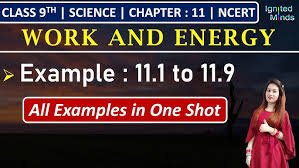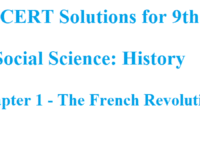
Detailed & Easy Notes
1. Work
- Work is said to be done when a force is applied and the object moves in the direction of the force.
Work = Force × Displacement × cosθ
Where θ is the angle between force and displacement.
Units:
- SI Unit: Joule (J)
- 1 Joule = 1 Newton × 1 metre
2. Positive, Negative, and Zero Work
| Type of Work | Example | Direction |
|---|---|---|
| Positive | Lifting object up | Force and displacement same direction |
| Negative | Friction | Opposite direction |
| Zero | Holding object still | No displacement |
3. Energy
- Capacity to do work
SI unit: Joule
1 kJ = 1000 J
4. Kinetic Energy (KE)
- Energy due to motion
KE = ½ mv²
5. Potential Energy (PE)
- Energy due to position or configuration
PE = mgh
m = mass, g = gravity, h = height
6. Work-Energy Theorem
- Work done on an object = Change in its kinetic energy
W = ΔKE
7. Power
- Rate of doing work
Power = Work / Time
SI unit: Watt (W)
1 kW = 1000 W
8. Commercial Unit of Energy
- Kilowatt-hour (kWh)
1 kWh = 3.6 × 10⁶ J
9. Law of Conservation of Energy
- Energy can neither be created nor destroyed. It can only be transformed from one form to another.
MCQs
- Work is done when:
a) Force is applied
b) Object moves
c) Force & displacement are same direction
d) All of these - Unit of work is:
a) Watt
b) Newton
c) Joule
d) kg - When is work zero?
a) Object moves
b) Force is applied
c) No displacement
d) None - Work done is negative when:
a) Force and displacement same
b) Force and displacement opposite
c) Force is zero
d) Displacement is zero - Formula of KE is:
a) mv²
b) ½mv
c) ½mv²
d) mgh - Potential energy depends on:
a) Mass
b) Height
c) Gravity
d) All of these - Unit of energy is:
a) Newton
b) Joule
c) kg
d) Watt - Power =
a) Work × Time
b) Work / Time
c) Force / Time
d) Time / Work - 1 kWh =
a) 1000 J
b) 3600 J
c) 3.6 × 10⁶ J
d) 100 J - Energy of a body at rest:
a) KE
b) PE
c) Heat
d) Power - Work-energy theorem relates:
a) Force and velocity
b) Power and time
c) Work and KE
d) Force and PE - Law of conservation of energy:
a) Energy destroyed
b) Energy increased
c) Energy transformed
d) None - 1 watt =
a) 1 J/s
b) 10 J
c) 100 J
d) 1 N/m - Unit of power:
a) Watt
b) Joule
c) Newton
d) kWh - What is commercial unit of energy?
a) Joule
b) kWh
c) Newton
d) Watt
Assertion & Reason
A: Work done is zero if object doesn’t move.
R: Displacement is necessary for work.
a) A and R true, R explains A
b) A and R true, R doesn’t explain A
c) A true, R false
d) A false, R true
A: Kinetic energy depends on speed.
R: KE = ½mv²
a) A and R true, R explains A
b) A and R true, R doesn’t explain A
c) A true, R false
d) A false, R true
A: Lifting object increases PE.
R: PE = mgh
a) A and R true, R explains A
b) A and R true, R doesn’t explain A
c) A true, R false
d) A false, R true
A: Energy can be destroyed.
R: It can vanish in space.
a) A and R true, R explains A
b) A and R true, R doesn’t explain A
c) A true, R false
d) A false, R true
A: Watt is unit of energy.
R: Energy = power × time
a) A and R true, R explains A
b) A and R true, R doesn’t explain A
c) A true, R false
d) A false, R true
Case-Based Study
Passage:
A boy lifts a bag of 5 kg to a height of 2 metres. Later, he throws it and it moves with a speed of 4 m/s. Assume g = 10 m/s².
- Work done in lifting bag = ?
a) 10 J
b) 50 J
c) 100 J
d) 20 J - PE of bag = ?
a) 50 J
b) 100 J
c) 20 J
d) 10 J - KE of bag after throw = ?
a) 20 J
b) 40 J
c) 60 J
d) 80 J - What form of energy bag had at top?
a) Only KE
b) Only PE
c) Both KE and PE
d) Zero - What does it prove?
a) Energy destroyed
b) Energy transformed
c) No energy
d) Force lost
Reason-Based Questions
- Why is work zero if there’s no displacement?
Because work = force × displacement. - Why is work negative against friction?
Because direction is opposite. - Why is kinetic energy scalar?
Because it has only magnitude. - Why does speed affect KE more?
Because KE ∝ speed². - Why is energy needed to do work?
Because energy is ability to do work. - Why do higher objects have more PE?
Because PE = mgh, more h = more PE. - Why is unit of energy Joule?
Because 1 Joule = 1 N × 1 m. - Why does a moving car have KE?
Because it has mass and velocity. - Why do we use kWh for electricity?
Because joule is very small unit. - Why is work done zero while holding bag?
Because displacement is zero. - Why is PE max at top of swing?
Because height is maximum. - Why is KE max at lowest swing point?
Because speed is maximum. - Why is power called rate of work?
Because power = work/time. - Why energy conserved during fall?
PE converts to KE. - Why is unit of power watt?
Because 1 watt = 1 joule/second.
Final Answer Key
MCQs:
1–d, 2–c, 3–c, 4–b, 5–c, 6–d, 7–b, 8–b, 9–c, 10–b, 11–c, 12–c, 13–a, 14–a, 15–b
Assertion & Reason:
16–a, 17–a, 18–a, 19–d, 20–d
Case-Based:
21–c, 22–b, 23–b, 24–c, 25–b



